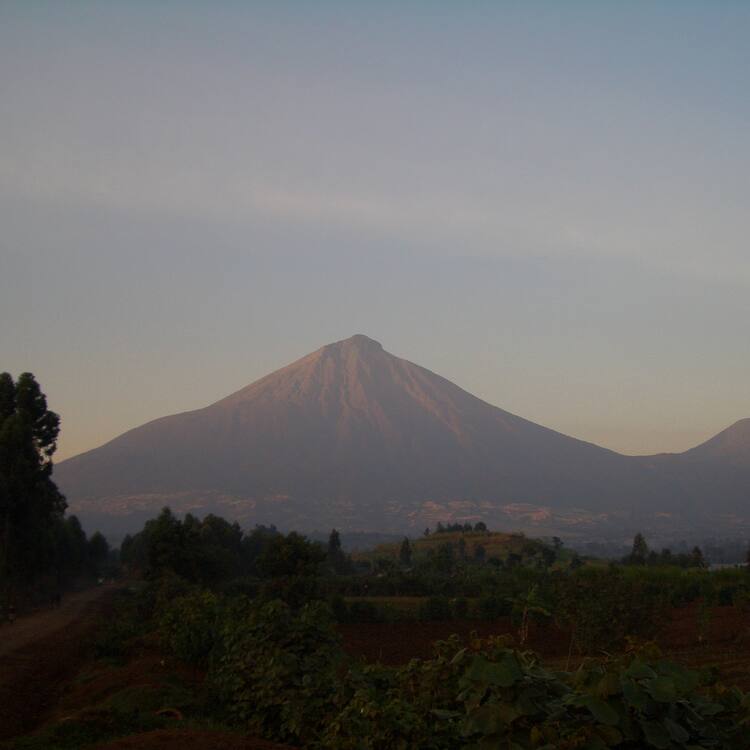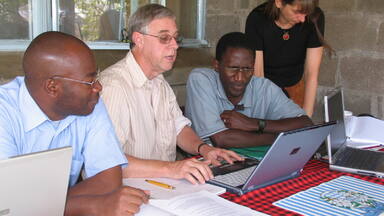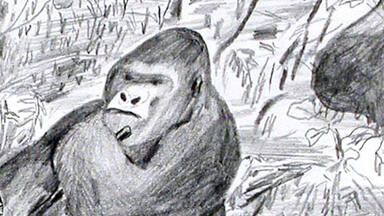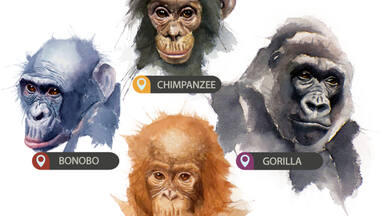Bwindi Impenetrable National Park
Bwindi Impenetrable National Park
Located in south-western Uganda, at the junction of the plain and mountain forests, Bwindi Park covers 32,000 ha and is known for its exceptional biodiversity, with more than 160 species of trees and over 100 species of ferns. Many types of birds and butterflies can also be found there, as well as many endangered species, including the mountain gorilla.
Description is available under license CC-BY-SA IGO 3.0
Forêt impénétrable de Bwindi
Situé dans le sud-ouest de l'Ouganda, à la jonction des forêts de plaine et de montagne, le parc de Bwindi s'étend sur plus de 32 000 ha et présente une très riche biodiversité avec plus de 160 espèces d'arbres et plus de 100 espèces de fougères. Il abrite également de nombreuses espèces d'oiseaux et de papillons, ainsi que plusieurs espèces menacées, dont le gorille de montagne.
Description is available under license CC-BY-SA IGO 3.0
الغابة العذراء بويندي
يقع منتزه بويندي في جنوب غرب اوغاندا عند ملتقى غابات السهل والجبل. وهو يمتد على اكثر من 32000 هكتار ويوفر تنوعًا بيولوجيًا غنيًا جداً يتألف من اكثر من 160 نوعًا من الاشجار واكثر من 100 نوع من السرخسيات. كما يأوي أيضًا العديد من فصائل العصافير والفراشات، بالاضافة الى عدة فصائل مهددة منها غوريلا الجبل.
source: UNESCO/CPE
Description is available under license CC-BY-SA IGO 3.0
布恩迪难以穿越的国家公园
布恩迪国家公园位于乌干达的西南部,处于平原和山区森林的交汇处,占地32 000公顷,以生物的多样性而闻名,它拥有160多种树木和100多种蕨类植物,这里是多种的鸟类和蝴蝶的栖息地,还生活着许多濒危物种,包括山地猩猩。
source: UNESCO/CPE
Description is available under license CC-BY-SA IGO 3.0
Национальный парк Бвинди-Импенитрейбл («Непроходимый лес Бвинди»)
Расположенный в юго-западной части Уганды в переходной зоне между равнинами и горными лесами, Бвинди-Импенитрейбл занимает площадь 32 тыс.га. Парк известен благодаря исключительно высокому биоразнообразию. Здесь произрастает более 160 видов деревьев и свыше 100 видов папоротников, обитает множество птиц и бабочек, отмечено много редких и исчезающих редких видов, включая горную гориллу.
source: UNESCO/CPE
Description is available under license CC-BY-SA IGO 3.0
Bosque impenetrable de Bwindi
Situado al sudoeste de Uganda, en el punto de convergencia de los bosques de planicie y de montaña, el parque de Bwindi tiene una superficie de 32.000 hectáreas y es reputado por su rica biodiversidad. Posee 160 especies de árboles y más de 100 clases de helechos, numerosos tipos de pájaros y mariposas, y varias especies animales en peligro de extinción como el gorila de montaña.
source: UNESCO/CPE
Description is available under license CC-BY-SA IGO 3.0
ブウィンディ原生国立公園
ウガンダ南西部に位置し、面積は約3万2000haにおよぶ。草原と森林が接する地域で人間が容易に入り込めないため、貴重な生物相が保たれている。160種を超す樹木や100種以上のシダ類のほか、さまざまな種類の鳥類やチョウ類、さらにはマウンテンゴリラなど、絶滅の危機に瀕している動植物も多い。source: NFUAJ
Nationaal Park Bwindi Impenetrable
Bwindi ligt in het zuidwesten van Oeganda, op de kruising van de vlakte en de bergbossen. Het Nationale park beslaat 32.000 hectare en staat bekend om zijn uitzonderlijke biodiversiteit, met meer dan 160 soorten bomen en meer dan 100 soorten varens. Verder zijn er veel vogel- en vlindersoorten te vinden, evenals vele bedreigde soorten, waaronder de berggorilla. Het park is een model voor het land - en mogelijk ook voor de hele Oost-Afrikaanse regio - vanwege integratie van duurzaam beheer van hulpbronnen. Er is echter nog steeds behoefte aan een betere bescherming van primaten op lange termijn.
Source: unesco.nl
Outstanding Universal Value
Brief synthesis
Bwindi Impenetrable National Park, covering 32,092 ha, is one of the largest areas in East Africa which still has Afromontane lowland forest extending to well within the montane forest belt. Located on the eastern edge of the Albertine Rift Valley and believed to be a Pleistocene refugium, the property is a biodiversity hotspot with possibly the greatest number of tree species for its altitude in East Africa. It is also host to a rich fauna including a number of endemic butterflies and one of the richest mammalian assemblages in Africa. Home to almost half of the world’s mountain gorilla population, the property represents a conservation frontline as an isolated forest of outstanding biological richness surrounded by an agricultural landscape supporting one of the highest rural population densities in tropical Africa. Community benefits arising from the mountain gorilla and other ecotourism may be the only hope for the future conservation of this unique site.
Criterion (vii): As a key site for biodiversity on the continent, the species richness occurring in this site, recognised also under criteria (x) below, can be considered as a superlative natural phenomenon.
Criterion (x): Due to its diverse habitats ranging from 1,160 to 2,706 m in altitude, location at the intersection of the Albertine, Congo Basin and Eastern Africa ecological zones, and probable role as a Pleistocene refugium, Bwindi is the most important area in Uganda for species due to an exceptional diversity that includes many Albertine Rift endemics. This forest is believed to be a mere remnant of a very large forest which once covered much of western Uganda, Rwanda, Burundi and eastern Democratic Republic of Congo (DRC). The property has the highest diversity of tree species (over 200 species including 10 endemics) and ferns (some 104 species) in East Africa, and maybe the most important forest in Africa for montane forest butterflies with 202 species (84% of the country’s total), including eight Albertine endemics. The forest is very significant as a home to almost half of the population (about 340) of the critically endangered mountain gorilla. With over 347 species of forest birds recorded in the Park,at least 70 out of 78 montane forest bird species occurring in the Albertine Rift region are found in the forest, and 22 of the 36 endemics. Overall, Bwindi hosts numerous globally threatened species including high-profile mammals such as mountain gorilla, chimpanzee, l’Hoest’s monkey and African elephant; birds such as African green broadbill, Grauer’s swamp warbler, Turner’s Eremomela, Chapin’s flycatcher and Shelley’s crimson-wing; and butterflies such as African giant swallowtail and Cream-banded swallowtail.
Integrity
The property is an oasis of forest situated inside one of the most densely populated rural areas in the country with more than 350 people per square km. This means that there is no possibility for a buffer zone at the forest edge apart from a buffer of 4 km2 which was donated by communities at the southern end of the Park to safeguard the site. It is recognized that the site is reduced in size and does not have an ideal boundary configuration, as the boundary area ratio is high and the area of park/people contact requires intensive management. There are several narrow corridors between sectors that will create difficulties for movement of wildlife. Due to human disturbance and clearing of vegetation there is little that can be done to expand the area around these constrictions.
The Park boundary is clearly delineated with planted trees and concrete pillars as markers along areas where rivers do not form the boundary. This clear boundary line has mostly stopped encroachment by the local communities, although with increasing population, agricultural encroachment will remain a potential threat. However, community participation programmes have enabled the neighbouring communities to derive various benefits from ecotourism and regulated plant resource use which significantly contributes to improving their livelihoods. There are no commercial activities inside the property other than ecotourism. Bwindi shares a common border with the small (c. 900 ha) protected Sarambwe forest in DRC, into which the gorillas and other species enter at times. This provides an opportunity for population dispersal and gene flow, and an avenue for international collaboration in conserving the region’s endemic and endangered flora and fauna.
Protection and management requirements
Managed by Uganda Wildlife Authority (UWA, UWA replaced Uganda National Parks (UNP) that was the management authority of the property at the time of designation), Bwindi is protected under the provisions of various national laws (The Constitution (1995), Uganda Wildlife Act Cap 200 of 2000, National Environment Act (2000), Local Government Act (1997), The Land Act (1998), the Forest and Tree Planting Act 2003 and the Uganda Wildlife Policy (1999). All these laws mentioned above were not in place by the time the property was inscribed as a World Heritage Site. However, the Uganda National Parks Act (1952), and the Game Act were already in place to support its creation) and international conventions (Convention of Biological Diversity 1992 (CBD), Convention on International Trade in Endangered Species (CITES), the Ramsar convention 1971 and the World Heritage Convention 1972). The site has an approved management plan and is highly respected and supported by local communities as a conservation site. The property attracts substantial support from a number of local and international NGOs. The Park has a permanent research institute located within the site which is engaged in research and continued monitoring of the site’s integrity. These factors as well as strong political support provide an assurance for the property’s long-term protection and conservation. The management of the site has developed ecotourism programmes that support community livelihoods, a major reason for community support. The Park is a model for integration of community sustainable resource management in the country and possibly in the East African Region. However, there are still strong long-term needs for greater primate protection given the new tendency of trafficking mountain gorilla babies and chimpanzees. As the mountain gorilla is so closely related to people, it is also threatened by transmission of human diseases as a result of tourism activities. UWA is closely monitoring these threats and working with stakeholders and NGOs to mitigate these threats. Continued enhancement of conservation is required in law enforcement and monitoring.

 View photos from OUR PLACE the World Heritage collection
View photos from OUR PLACE the World Heritage collection









